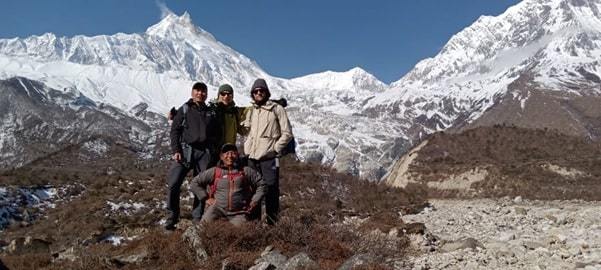Featured Image Caption: Four People with Backpacks Standing on the Mountain
Jump to read...
Trekking through the magnificent trails of Annapurna is an exhilarating journey; however, ventures into such high altitudes come at a cost, as most trekkers are frightened of the maladies that could follow. The threat of headaches, sickness, or worst case, altitude sickness itself is a deterrent for many adventure lovers. Nonetheless, a solid acclimatization strategy is paramount to tackling the sense of fear. Being acclimated properly helps your body adjust gradually to lower oxygen levels, which will maximize safety while increasing confidence.
Annapurna is tall–topping 5,000 meters or so in elevation–and warrants some respect. Not factoring in the effects of altitude can turn a dream trek into a nightmare. Come the right way, including a slow climb, enough rest, and listening to your body, you can completely evaporate “fear of height”. The following detailed acclimatization guide is written exclusively keeping in mind the Annapurna trekkers so that you can trek safely, have fun, and make it a life-changing experience.
How Quickly You Lose Acclimation to Altitude
Acclimation is rapidly lost as a person descends from high altitudes in Annapurna Base Camp, typically taking days to weeks. Usually, within 3 -7days of having been at low altitude, your body’s de-acclimatization to high altitude begins. Full loss can also occur within 2-4 weeks. So re-acclimation is needed if going back to high altitude after this time.
Start Low and Slow
Start slow to give your body a chance to acclimate. Do not go too high too fast in the first few days; spend some time walking around in Nayapul or Ghandruk. Less oxygen feels like you are breathless, so this slow build-up readies your lungs and blood to work better with less oxygen, putting you in a good position for the higher parts.
Schedule Rest and Acclimatization Days
Including a rest day in places where it makes sense, like Manang and Jhinu Danda. These restoration days give your body time to recover and adapt to the multiplied altitude. Take nowadays to drink sufficient water, devour nutrient-dense ingredients, and keep away from exercising. Getting sufficient sleep prevents altitude sickness and keeps a healthy stamina for the days to come.
Screen symptoms intently
In case you are aware of signs and symptoms, including headaches, dizziness, nausea, or fatigue. Early reputation is crucial. Assess yourself by looking for little signs, like how you are breathing and your mental alertness. If the signs worsen, rest or cross down.
Live hydrated and devour well
The better you pass, the drier your insides, so make sure you drink masses of water each day to fight off dehydration and, as a result, reduce altitude sickness. You should be getting in at least 3-4 liters a day. Eat a variety of carbohydrates such as bread, cereal, and pasta to stay fueled or maintain your energy. Step on Consumption of alcohol and caffeine can cause you to become dehydrated, not to mention getting in the way of your acclimatization.
Use Acclimatization Aids Wisely
Diamox is a medication that can improve acclimatization, but it should be taken only under the advisement of your doctor. They can help reduce symptoms and are thought to augment adaptation. Also, take oxygen supplements or keep portable oxygen cylinders in case of emergencies. These are aids only and should never take the place of good acclimatising practices.
Plan for Flexible Itineraries
The circuit of Annapurna is a trek tested for flexibility. Trail conditions, weather, and maintenance may necessitate changes; Prepare to offer additional days off or to modify routes. Hiring knowledgeable guides who have a firm grasp of acclimatization theory means you can be confident in your plan’s ability to flex as necessary, keeping trekkers safe and worry-free.
How do you adapt to the altitude so altitude illness no longer catches you out?
Ascend slowly to acclimate by no means climb greater than three hundred-500 meters above 3,000 meters in keeping with day. Relaxation as properly: At better elevations, relaxation days every 2-three days to acclimate. Have plenty of water, suitable vitamins, no alcohol, and stay symptomatically vigilant. Do not maintain going better, as it may convey altitude sickness. If feeling ill, begin mountain climbing up or descending.
What happens to acclimatization to high altitudes?
Rest for added days at a middle altitude, stay hydrated, and devour a high-carb diet to assist acclimatization more quickly. Moving your body moderately helps it to adapt more quickly. Others take a medication such as acetazolamide (Diamox) under the care of their physician to expedite acclimatization. Refrain from alcohol and smoking, climb at high altitudes during the day but sleep at lower (“climb high, sleep low”).
Preparing the frame to acclimatize to high altitude
Get in shape through undertaking cardiovascular exercise, particularly before going on a hike. Find out about altitude illness signs and symptoms, and carry medications in case you want to apply them. Break up your routine with long drive days and off planning. Bring layers for when it gets cold, stay hydrated, and lay off the alcohol. Acclimation success is also achieved by mental preparation and personalized suggestions from a physician.
By Sherpa Expedition Teams
– Sherpa Expedition & Trekking Pvt. Ltd. is one of Nepal’s oldest adventure companies, founded in 1977. Based in Kathmandu, it offers safe, personalized trekking and mountaineering experiences led by expert local guides, with a strong focus on sustainability and ethical tourism.
Member since September, 2025
View all the articles of Sherpa Expedition Teams.



















Leave a Reply